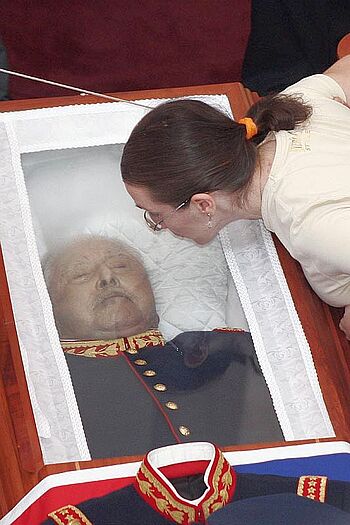The Republic of Chile is the most economically and socially stable country in South America. Its democracy looks back on a tradition of almost 200 years. However, the country has experienced many political crises in the past. The overthrow of the socialist president Salvatore Allende in 1973 and the establishment of a military dictatorship under Augusto Pinochet continue to weigh heavily on the country today.
Pinochet’s Long Shadow

Credit: En Todos Lados !!'s. / CC BY
Chile – officially the Republic of Chile – is the longest country in South America, running from the middle of the subcontinent to the furthest southern point. 17.5 million people live here on an area of 756,000 square kilometers. About 70 percent of the population is Roman-Catholic.
After independence was achieved in 1818, the history of the former Spanish colony was marked by wars, upheavals and frequent changes of government. Conservatives and liberals, the right and the left, often had irreconcilably differences. A civil war began in 1891, which claimed some 6,000 lives. Only in the last three decades has the country evolved into a stable democracy that is economically viable. In 2018 Chile was removed from the list of developing countries.
The military often played a central role in the country’s many domestic and foreign policy disputes. In 1924, for example, a group of officers staged a coup against elected president Arturo Alessandri, who eventually resigned and went into exile. Although the military brought him back a half-year later, he resigned again after only a few months in response to another impending coup. The strong man during this time was the director of the Cavalry School in Santiago de Chile, Carlos Ibáñez del Campo, who held various ministerial posts and declared himself president of Chile in 1927. His dictatorial regime lasted four years until he was forced to resign by a general strike. Following another military coup, this time by the Socialists, Alessandri, who had returned from exile, was re-elected president in 1932.
An influential National Socialist movement emerged in Chile in the 1930s. A coup d'état that was attempted in 1938 was bloodily defeated. At the time, the left-wing forces that had founded the Frente Popular in 1936 and formed the government for a few years gained momentum. Until 1952 all the presidents had come from the left-liberal Radical Party. But the political system proved extremely unstable. Carlos Ibáñez became president again in 1952, but this time through free elections. His opponents included a man who would later become world-famous -- the doctor and politician of the Socialist Party, Salvador Allende.
It was only after two more unsuccessful attempts that Allende won the 1970 presidential election -- with 36.3 percent of the valid votes -- after the socialists, communists and other left-wing parties merged to form Unidad Popular. His left-wing government alliance nationalized copper mines, coal mining, banks, the textile industry and major foreign companies. In addition, the government expropriated and redistributed 20,000 square kilometers of land. The state also set rents and prices for basic foodstuffs. Increased government spending stimulated economic growth, but inflation reached record levels. Chile fell into a deep economic crisis, accompanied by strikes, demonstrations, land occupations and terrorist attacks.
Although the military was integrated into the government and the Unidad Popular received an increase in votes in the 1973 parliamentary elections, the armed forces staged a coup against President Allende in September. After he refused to resign, the presidential palace was bombed. When the building was stormed, Allende shot himself while his supporters spread the rumor that he had been murdered. Throughout the world he became a martyr of leftist movements. General Augusto Pinochet, commander-in-chief of the armed forces who also appointed himself president in 1974, took power. The military junta had thousands of Allende's followers arrested and interned in two large sports stadiums in the capital. It also set up secret prisons where it brutally tortured opposition members. The Colonia Dignidad, a sect-like settlement established by German emigrants, also served as a torture center at the time. At least 40,000 people were arrested and more than 3,000 died. Another 250,000 Chileans went into exile, including some 2,000 who moved to the GDR.
Free elections were not held until late 1989, which led to the election of Christian Democrat Patricio Aylwin as president. He set up a truth and reconciliation commission to investigate the political murders committed under Pinochet. In 1993, several officers were indicted for the first time. Like most of the people responsible, Pinochet, who remained Army Chief of Staff until 1998, was never convicted in court.
The socialist presidents Ricardo Lagos (2000-2006) and Michelle Bachelet (2006-2010 and 2014-2018) were most pivotal in advancing efforts to address the legacy of the 16-year military dictatorship. Lagos set up a second commission, which also investigated arrests and torture. Bachelet, who was imprisoned under Pinochet, initiated the construction of a museum of memory and human rights, which she opened in 2010.
To this day, the Pinochet dictatorship lies like a shadow over Chilean society. The country is divided in its judgment of this period. Not until November 2019 did the conservative government and left-wing opposition agree in a referendum on whether to replace the constitution enacted during the military dictatorship with a new one. In October 2020, 78 percent voted in favor of it (as of November 2020).
Republic of Chile

Area: | 756,102 km² |
|---|---|
Inhabitants: | 17.6 million (2017) |
Population growth: | 0.8 % annually (2016) |
Population density: | 23 inhabitants per km² |
Seat of government: | Santiago de Chile |
Official language: | Spanish |
Political system: | Presidential democracy |
Head of state: | President Sebastián Piñera (2010-2014 and since 2018) |
Head of government: | President Sebastián Piñera (2010-2014 and since 2018) |
Freedom status: | 90/100 |
GDP per capita: | 25,700 USD (adjusted for purchasing power, 2018) |